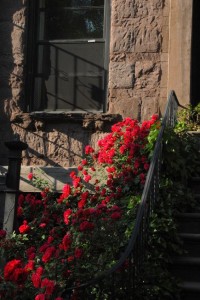Article by Nicole LaRosa
Luxury condos are sprouting up like weeds, but rest assured: the brownstone charm of Boerum Hill is here to stay.
 New York City Council approved new zoning regulations last week that ensure the landmarked neighborhood will now fall under similar height restrictions as its “brownstone belt†neighbors in Carroll Gardens and Cobble Hill.
New York City Council approved new zoning regulations last week that ensure the landmarked neighborhood will now fall under similar height restrictions as its “brownstone belt†neighbors in Carroll Gardens and Cobble Hill.
In a Sept. 21 vote, the Council approved a 40- to 50-foot cap on most new development in the historic section of Boerum Hill, where many homes are more than 150 years old.
Residents had fought hard to protect their quaint tree-lined blocks from rising towers, not long after fighting and losing a battle over the imposing development of the nearby Atlantic Yards project.
City Councilman Stephen Levin, a big proponent of the rezoning, said he was “thrilled†at the vote, and thanked the Boerum Hill Association and the community for “maintaining the historic character of their neighborhood.â€
The new zoning applies to a 31-block area bound by Atlantic Avenue to the north, 4th Avenue to the east, Warren and Wyckoff streets to the south, and Court Street to the west. Previous zoning allowed for tall apartment buildings that residents said were out of character.
While residential streets will be now be held to a 50-foot cap, buildings on thoroughfares like 3rd avenue can rise to 80 feet, with a setback. (See map below.)
Buildings in Carroll Gardens and Cobble Hill are subject to similar zoning, though the city stopped short of granting landmark status to Carroll Gardens—a proposal that will be up for debate this fall.
Local artist Therese Urban fought against the Atlantic Yards development. She’s grateful that the new zoning will keep the rising towers of Downtown Brooklyn out of Boerum Hill.
“Having a lovely neighborhood that has been cared for for 150 years is an important thing in America and it’s an important thing in Brooklyn,†said Urban, 67, a Boerum Hill Association member who raised four children in the leafy enclave.
“There’s a place for everything—in its place.†She welcomes new larger buildings on 3rd and 4th avenues but insists that preserving the charm of the residential streets brings a cohesiveness that was lacking in the area disrupted by the new Barclay Arena stadium.
Not everyone is happy about the new zoning laws. Developer Frank DeFalco told the Brooklyn Paper the height cap thwarted his plans to build artists’ housing over his Invisible Dog gallery on Bergen Street.
“We believe the rezoning was completely well-intentioned, but it will stifle places like The Invisible Dog,†DeFalco said. “We’re trying to build a vibrant arts community and the only way that’s going to happen is if we have room for growth in the future.â€
Shops and restaurants will also be affected by the new law, which requires that only businesses that serve local needs be allowed to open. It will also prevent commercial spaces from encroaching onto residential side streets.
The city approved similar zoning for Carroll Gardens in 2009 after a two-year battle, but some area preservationists want to go farther than a zoning height regulation, with a landmark status for a large chunk of Carroll Gardens. Currently, only a tiny section just east of Carroll Park is landmarked. (Most of Cobble Hill and Brooklyn Heights is landmarked.)
Opposition to the movement is fierce, as some old-time residents feel landmark status will make home improvements prohibitively expensive.
Activists on both sides will debate the issue later this fall at Carroll Gardens Neighborhood Association monthly meetings.
Check out Brownstoner.com’s colorful map of the new down-zoned, height-capped area.
